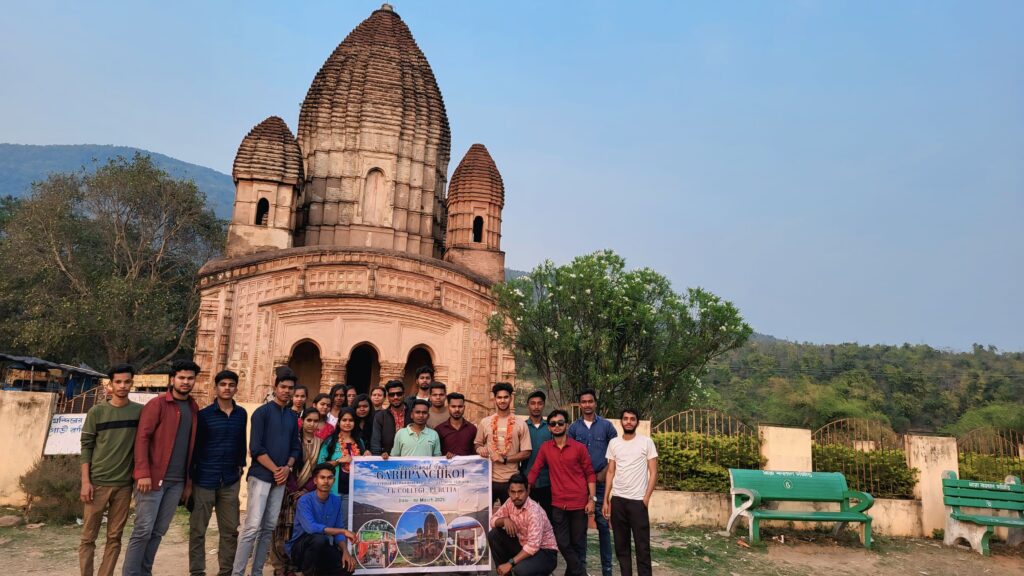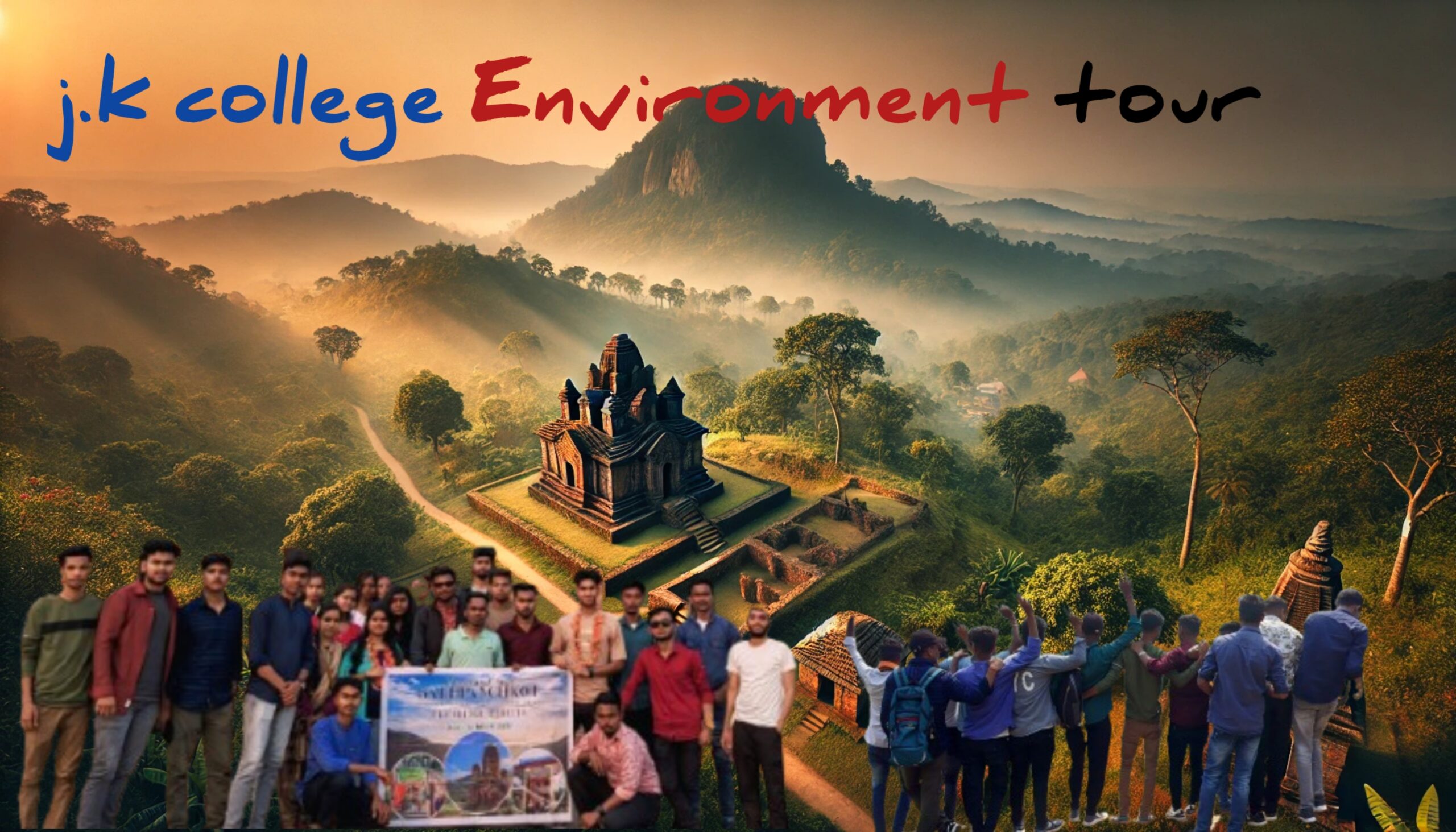Gar Panchkot Environment Tour transforms learning experience for J. K. College’s Political Science Department
The Department of Political Science has recently started organizing an environmental tour to Gar Panchkot where history meets nature and governance. Located at the foothills of Panchet Hill in Purulia, West Bengal, this place is known for its stunning landscape, ancient ruins and rich biodiversity. The idea is to provide students with an experiential learning opportunity to connect political governance with environmental conservation.
Unveiling the Natural and Historical Significance
Gar Panchkot is an ecological and historical site. It was once a kingdom and today, the ruins of the fort of the Panchkot dynasty remind one of its glorious past. It is surrounded by forests, waterfalls and wildlife.
Students explored fort ruins, forests and water bodies and learnt about the region’s history and biodiversity. Discussions focused on government policies for heritage conservation, environmental sustainability and responsible tourism.
The impacts of greenhouse gases (GHGs), CO2 and other harmful gases on Earth are great.
1. [Global Warming] – Excess CO2 and GHGs trap heat and raise global temperatures.
2. Climate Change – Causes extreme weather like hurricanes, droughts and floods
3. Melting Ice Caps & Rising Sea Levels – Warmer temperatures cause glaciers to melt, leading to coastal erosion and flooding.
4. Air Pollution & Health – CO2, methane (CH4), and sulfur dioxide (SO2) cause respiratory diseases, heart problems, and other health effects.
5. Acid Rain – Sulfur dioxide (SO2) and nitrogen oxides (NOx) react with water vapor to form acid rain, which damages crops, buildings, and aquatic life.
6. Ocean Acidification – CO2 dissolves in seawater, making it more acidic and damaging marine life like corals and shellfish.
7. “Biodiversity loss”– Warming and pollution disrupt ecosystems and cause species extinction.
8. “Agricultural Impact”- Crop yields are affected by climate change and lead to food shortages and economic instability
9. “Ozone layer depletion” – CFCs damage the ozone layer and increase UV radiation exposure.
10. Wildfires and desertification – More frequent and larger wildfires and a greater extent of desertification
Conclusion
Excessive greenhouse gas and pollutant emissions are threatening the balance of our planet. Immediate action, including reducing carbon footprints, promoting renewable energy, and enforcing environmental regulations, is needed to protect Earth for future generations.
Solutions to Reduce Greenhouse Gases (GHGs) and Protect the Environment 1. Use Renewable Energy – Shift from fossil fuels to solar, wind, and hydroelectric power.
2. Increase Energy Efficiency – Use LED bulbs, energy-efficient appliances, and smart grids to reduce energy consumption.
3. Reduce Carbon Emissions – Promote electric vehicles, public transportation, and carpooling to lower fuel consumption.
4. Afforestation & Reforestation – Plant more trees to absorb CO₂ and restore natural ecosystems.
5. Adopt Sustainable Agriculture– Use organic farming, reduce chemical fertilizers, and practice crop rotation to cut emissions.
6. Reduce, Reuse, Recycle – Minimize waste production and encourage recycling to decrease industrial pollution. .
Protecting the environment requires collective action from individuals, businesses, and governments By adopting sustainable practices, reducing carbon emissions, and preserving natural resources, we can mitigate climate change and safeguard our planet for future generations.

Environmental Conservation and Sustainable Development
The group also learned about governance as it related to environmental preservation and observed the biodiversity in the area and the effects of human activity such as deforestation and tourism on the ecosystem.
Through discussions and interactive sessions, students analyzed:-
- The role of -Panchayati Raj institutions in environmental governance
- How -government policies impact eco-tourism and local development
- Strategies for -sustainable development- in ecologically sensitive areas.
The tour also helped students to think about how politics affects the conservation of the environment and the importance of community to balance the ecology.
Engaging with the Local Community
A key part of the visit was
communicating with local villagers – about their experiences and challenges in natural resource management, and gaining insights into traditional knowledge systems, local governance, and grassroots environmental activism.
The discussions with locals helped students understand:-
- The economic dependence on natural resources.- Community-led efforts in forest conservation and water management.-
- How local self-governance contributes to environmental sustainability.
A Journey Beyond the Classroom
The Gar Panchkot trip was more than just a sight-seeing trip; it was an eye-opener. The students learnt practical lessons in political and environmental dynamics and understand the importance of policy-driven conservation efforts.
These field trips help students connect theory to practice and inspire them to create a sustainable future. The Department of Political Science at J. K. College organized an unforgettable experience that helped us better understand environmental policies, governance and community engagement.
When they returned to school, the students had a memory of splendid scenery and a sense of responsibility toward nature and society.
